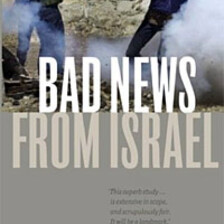The Electronic Intifada 25 June 2011
Glasgow University Media Group’s ambitious new study of British TV’s coverage of Israel and the Palestinians, More Bad News from Israel, is the second edition of 2004’s Bad News From Israel. Led by academics Greg Philo and Mike Berry, this work is precise, fair-minded and detailed. It constitutes irrefutable evidence of endemic pro-Israel bias.
Those of us regularly subjected to BBC and ITV news won’t exactly find this conclusion surprising but the importance of detailed documentary evidence like this book provides cannot be overstated.
The team had originally analyzed approximately 200 bulletins and questioned more than 800 persons. This new edition examines coverage from the past few years (369). Samples of coverage were taken from the main news bulletins on BBC and ITV (the most popular TV news programs in the UK). The authors identify key themes, such as coverage of casualties on “either side,” justifications for violence and “peace conferences” and international diplomacy. Audiences from a variety of socio-economic backgrounds were asked to complete a series of questionnaires and take part in focus groups. The vast majority reported that TV news was their primary source of information on Israel and the Palestinians.
The samples, taken from key moments in recent history, are well chosen. The focus of the initial study was coverage of the second Palestinian intifada’s outbreak in 2000 (in the first two weeks of which, Israel, by its own soldiers’ accounts, fired a million bullets at unarmed protesters). The next samples are taken from one year later (by which time Palestinian groups had started retaliatory bombings within Israel), and from coverage of the March and April 2002 Israeli re-invasions of the occupied West Bank.
The new chapters look at coverage of Israel’s 2008-09 winter assault on Gaza and the Israeli attack on the Gaza Freedom Flotilla a year ago (which was breaking news at the time the book was due to go to print).
Systematic preference for Israeli points of view
By fastidiously counting lines of transcript text, the authors identify a systematic preference for Israeli points of view. Israeli speakers were given twice as much space as Palestinians during the first few weeks of the intifada (215). Israeli casualties were disproportionately reported, accounting for approximately a third of the coverage, despite the actual ratio of 13 Palestinian deaths to one Israeli at that stage (223). After the Palestinian retaliatory bombing campaign began, this phenomenon worsened: “from October to December 2001 we found that there was significantly more coverage of Israeli casualties than Palestinian” even though the reality was actually still the opposite (259-60).
The study’s most telling findings concern the dominant explanatory framework and the lack of background or historical context in coverage. Even when individual journalists manage to make implicit criticisms of Israeli actions, such as on the killing of civilians, Israeli rationales were always reported — or even adopted by journalists themselves. “The journalists do not always sound happy about the Israeli rationales” but they were still included and “there is no comparable inclusion or discussion of the reasons for Palestinian action” (254).
The authors give many examples of this, including an ITV report from March 2002 that described Israeli collective punishment destroying civilian infrastructure around Bethlehem as “the ongoing fight against terror.” But there are “no commentaries such as ‘the Israeli attacks have reinforced the determination of Palestinian fighters to defend their land against Israeli terror’ [and] … we do not hear of Palestinian attacks as sending ‘a tough message to Israelis to end military rule’ ” (265). Such statements are unimaginable on British TV.
“All bang bang stuff”
One BBC journalist was told by his editor he wasn’t interested in “explainers” since “it’s all bang bang stuff” (180-1). But the audience studies here reveal “a strong feeling in the [focus] groups that the news should explain origins and causes” (315). This is unsurprising, considering that audiences questioned here often did not even know what nationality “settlers” were, or that there was a military occupation of the West Bank (400-1).
The two key historical events missing from the narrative of TV news are the Nakba (Arabic for “catastrophe”), what Palestinians call the ethnic cleansing and dispossession of their homeland in 1947-48, and the military occupation that started in 1967 (333). One student in a focus group said: “I didn’t realize they [Palestinians] had actually been driven out” (292). As the authors put it: “these absences in public knowledge very closely parallel the absence of such information on the TV news” (294).
The new audience studies for this second edition looked at whether anything has changed since 2004. The answer for the most part seems to be no. Coverage of Palestinian casualties seems to have increased, but Israeli casualties are still over-represented proportionate to the level of Palestinian deaths (363). Overall, the “most striking feature” of the new samples was “the dominance of the Israeli perspective” (340).
Has the tide turned on perceptions of Palestine?
Many of us who follow Western perceptions of Palestine have gained optimism by detecting a slow but positive shift in public opinion in support of Palestinians over the last couple of years. Perhaps that is still true, but the new findings here give pause for thought. The framework of assumptions is still overwhelmingly influenced by the Israeli version of events. In other words, Palestinian actions are always assumed to lead to Israeli “responses.”
The original study revealed that the “Israeli response to Palestinian violence” formula was so all-pervasive that the infamous Israeli killing of Gaza schoolboy Muhammad al-Dura in the first days of the intifada was understood by many as as “response” to a killing of two Israeli soldiers in Ramallah — even though the latter event actually took place afterwards (305). The updated audience studies here suggest that this malign phenomenon has not changed.
Palestinian rockets from Gaza were still seen by many as the main reason for Palestinian civilian deaths: “Palestinians are seen as initiating the violence … [so] it follows that Israel is ‘retaliating’ ” (378). On the BBC during the sample period 27 December 2008 to 17 January 2009, Israel’s November 2008 violation of the ceasefire with Hamas was mentioned in only 4.25 lines of transcript, compared with 249 lines of text that emphasized the firing of Palestinian rockets into southern Israel (419).
The weakest part of the book is the chapter “Why does it happen?” which offers some tentative explanations for the problematic patterns in the studied coverage. The influence of the Israel lobby is over-emphasized here and there is little analysis of real shared values between the United States, the United Kingdom and Israel, such as imperialism, military hegemony, Orientalist assumptions and racism. There are revealing statements by some in the focus groups that I would have liked to have seen pursued. One person thought Palestinians and Israelis fight “because that’s what their ancestors did and that’s what they know how to do” (374).
Despite this flaw, More Bad News from Israel is a valuable tool in understanding mass media coverage and popular opinion on Israel and the Palestinians. If journalists are to present the Palestinian perspective to people in the West, these are important issues to understand.
Asa Winstanley is a freelance journalist based in London who has lived in and reported from occupied Palestine. His first book, Corporate Complicity in Israel’s Occupation, will be published by Pluto Press in October. His website is www.winstanleys.org.




